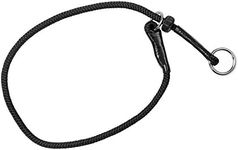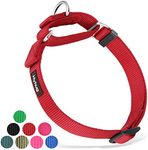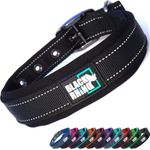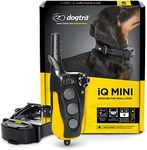Buying Guide for the Best Dog Training Collars
Choosing the right dog training collar can make a significant difference in your pet's training experience. It's important to understand the various features and specifications to ensure you select a collar that is safe, effective, and suitable for your dog's specific needs. Here are some key specifications to consider when picking a dog training collar.Type of CollarThere are several types of dog training collars, including static (shock) collars, vibration collars, ultrasonic collars, and spray collars. The type of collar you choose depends on your dog's temperament and the specific training goals. Static collars deliver a mild electric shock, which can be effective for stubborn dogs but should be used with caution. Vibration collars use vibrations to get the dog's attention and are generally considered gentler. Ultrasonic collars emit a high-pitched sound that is unpleasant to dogs but inaudible to humans. Spray collars release a burst of citronella or another harmless substance. Consider your dog's sensitivity and the behavior you are trying to correct when choosing the type.
RangeThe range of a dog training collar refers to the maximum distance at which the remote can communicate with the collar. This is important for outdoor training or if you have a large property. Ranges can vary from a few hundred feet to several miles. For basic home training, a shorter range may suffice, but for field training or off-leash activities, a longer range is beneficial. Assess your training environment and choose a collar with an appropriate range.
Levels of StimulationDifferent collars offer varying levels of stimulation, which can be adjusted to suit your dog's sensitivity and training needs. This is crucial for ensuring the collar is effective without causing unnecessary discomfort. Collars with multiple levels allow you to start with the lowest setting and gradually increase it if needed. For dogs that are more sensitive or for basic training, fewer levels may be sufficient. For more stubborn dogs or advanced training, a collar with a wider range of levels is preferable.
WaterproofingWaterproofing is an important feature if your dog will be training in wet conditions or if they enjoy swimming. A waterproof collar ensures that the device will continue to function properly even if it gets wet. Some collars are water-resistant, meaning they can handle light rain or splashes, while others are fully waterproof and can be submerged. Consider your dog's activities and choose a collar with the appropriate level of waterproofing.
Battery LifeBattery life is a practical consideration, as it determines how often you will need to recharge or replace the batteries. Longer battery life is more convenient, especially for extended training sessions or outdoor activities. Some collars come with rechargeable batteries, while others use replaceable ones. Think about how often you will be using the collar and choose one with a battery life that matches your needs.
Fit and ComfortThe fit and comfort of the collar are crucial for your dog's well-being. A collar that is too tight can cause discomfort or injury, while one that is too loose may not be effective. Look for collars with adjustable straps to ensure a snug but comfortable fit. Additionally, consider the material of the collar; softer materials may be more comfortable for your dog to wear for extended periods. Always measure your dog's neck and follow the manufacturer's sizing guidelines.

















